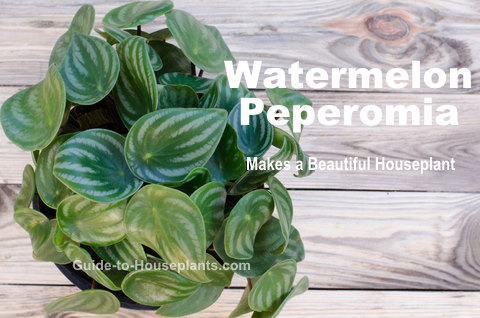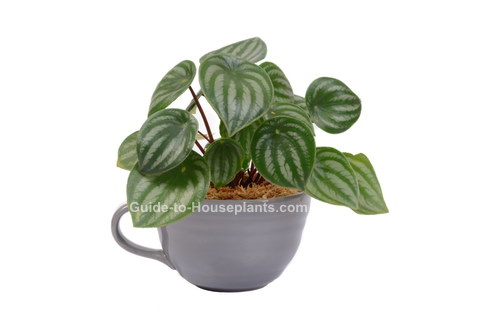Watermelon Peperomia Care
Botanical Name: Peperomia argyreia
Small, yet dramatic -- that's Watermelon Peperomia. Its silvery striped leaves complement other houseplants and they stand pretty well on their own, too.
Here you'll discover how to water, when to fertilize, how to repot, and grow Peperomia argyreia indoors with success.

Get to Know Watermelon Peperomia
This rain forest native-turned-houseplant has an easy-care nature. Watermelon Peperomia is eye-catching, too, making it a popular indoor plant for several decades.
It's long-lasting and usually trouble-free. Any problems are usually related to watering.
Known botanically as Peperomia argyreia, this Brazil native is perennial and evergreen. It's one of the clumping Peperomias that grow in a rosette. How big does it get? A fully grown houseplant will reach up to 10 in (25 cm) tall, and spread about as wide.
The Peperomia family of plants offers quite a variety for growing indoors. What really sets this beauty apart is its shiny, silvery striped foliage. I think it is one of the prettiest of the bunch.
Does Watermelon Peperomia bloom? Yes, you can expect slender, green flower spikes in summer, with enough sunlight. They're not at all showy, but one of the hallmarks of Peperomias.
Watermelon Peperomia Problems, Solutions and Answers
Wilted leaves typically indicate a plant is thirsty. However, this slow-growing plant will wilt from root rot, caused by over-watering. Roots need air, too. Use a pot with drainage holes. If you want to cover a plain nursery pot, slip it into a cachepot -- a decorative pot without drainage holes. I put small rocks in the bottom of cachepots to hold the inner pot above the drainage water.
Black leaves and stems are caused by crown rot. You over-watered. Cut off affected leaves and allow the potting mix to dry out a bit before watering again.
Repot in spring only when you see roots pushing up through the soil, or growing out of the drainage holes. Peperomia argyreia is slow-growing and grows best in a small pot. Soil can become compact over time, so it will benefit from repotting every couple years, just to refresh the soil. When repotting, don't pack down the soil -- keep it loose.
Is Peperomia pet-friendly? Yes, according to the ASPCA, Watermelon Peperomia is non-toxic to cats and dogs, making it a safe choice indoors.
Something bugging your plant? Wet, peaty potting mixes can attract fungus gnats. They look like tiny black flies that hop or crawl on the soil. Sometimes fungus gnats arrive with a plant from the garden center, or come with a bag of moist potting mix. Treat an infestation right away because these pests will multiply quickly and move on to your other indoor plants. Scale, mealybugs and spider mites are other possible pests.

Watermelon Peperomia Care Tips
Light: Bright light, but no direct sun. Small leaves or leggy stems indicate the plant is not getting enough light.
Water: Water thoroughly, then allow the top 2 in (5 cm) to dry out before watering again. One of the few things that bother Peperomias is soggy soil, which can lead to root rot. If you believe you've hopelessly over-watered, ease the plant out of its pot and take a peek at its roots. If they're soft, brown and mushy, toss it out; it won't recover. If the roots are firm and white, repot right away in fresh potting mix. Water sparingly in winter, when growth is slower. Always water your houseplants with lukewarm water because cold water is a shock to them.
Humidity: Aim to maintain at least 50% relative humidity around Watermelon Peperomia. Set the plant on a tray of wet pebbles or use a cool-mist humidifier. Brown leaf tips are a sign of dry air.
Temperature: Average room temperatures (65-75°F/18-24°C). This South American native doesn't like fluctuating temperatures; keep it away from heat/AC vents and cold blasts from doors and windows. Cold air may cause its leaves to fall off.
Soil: Peat moss-based mix with added perlite and/or vermiculite for faster drainage. African violet potting mix is ideal for growing Peperomias indoors.
Fertilizer: Peperomia argyreia is not a heavy feeder. Because it's slow-growing, too much fertilizer can burn its roots. Feed once a month spring through fall with a balanced (such as 10-10-10 NPK) water-soluble fertilizer at half the recommended strength.
Propagation: Take stem tip cuttings in spring and early summer. Watermelon Peperomia roots easily in moist perlite or potting mix.


